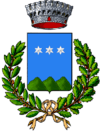Acri
| Acri | ||
|---|---|---|
| Comune | ||
| Comune di Acri | ||
|
| ||
| ||
 Acri Location of Acri in Italy | ||
| Coordinates: 39°30′N 16°23′E / 39.500°N 16.383°E | ||
| Country | Italy | |
| Region | Calabria | |
| Province | Cosenza (CS) | |
| Frazioni | Acqua di Fico, Bellucci, Canaletta, Casalinella, Ceraco, Ceracò, Chimento, Cocozello, Corneto, Croce di Greca, Croce Don Paolo, Cuore di Maria, Cuta, Duglia, Ferrante d'Aragona, Foresta, Gallone Pane, Gioia, La Mucone, La Mucone Sottano, Manca e Galera, Milano, Mischinella, Monsignore, Montagnola, Ordichetto, Pagania, Pagania del Vallone, Pantadia, Pantalea, Pantano d'Olmo, Pantano il Melo, Pantano Soprano, Pantano Sottano, Pastamolla, Petramorella, Piana di Caruso, Pietremarine, Pinitello, Policaretto, Pozzometro, Pucchio, Salice, San Giacomo d'Acri, San Lorenzo, San Martino, Sant'Adriano, Sant'Angelo d'Acri, Santa Maria la Fiumara, Santo Zaccheria, Serra di Cristo, Schito, Serra di Vuda, Serralonga, Serricella, Settarie, Sorbo, Vallone Cupo, Vallone il Melo, Vallone il Pero, Vallone U Midu, Vagno, Vammana, Vupo | |
| Government | ||
| • Mayor | Pino Capalbo | |
| Area | ||
| • Total | 200.63 km2 (77.46 sq mi) | |
| Elevation | 720 m (2,360 ft) | |
| Population (30 October 2017) | ||
| • Total | 20,480 | |
| • Density | 100/km2 (260/sq mi) | |
| Demonym(s) | Acresi, Acritani | |
| Time zone | UTC+1 (CET) | |
| • Summer (DST) | UTC+2 (CEST) | |
| Postal code | 87041 | |
| Dialing code | 0984 | |
| Patron saint | Saint Angelo d'Acri | |
| Saint day | 30 October | |
| Website | Official website | |
Acri (Calabrian: Eacri; Calabrian Greek: Acra) is a town and comune in the province of Cosenza in the Calabria region of southern Italy.
Main sights
The town's principal churches have survived various earthquakes over the centuries and have preserved their historical and architectural significance. S. Maria Maggiore Church was rebuilt in the 17th century but preserves a wooden crucifix dating from the 14th century and other noteworthy works are the 16th century S. Francesco di Paolo and the Madonna of Rinfresco. Other works of art can be found in the Capuchin Convent and the mediaeval Annunziata Church.
The Church of Saint Angelo d'Acri and the adjacent museum contain artifacts of the namesake of the church, Saint Angelo. In the museum is the real room where Saint Angelo spent days praying and many articles of his clothing and religious implements. The body of Saint Angelo is displayed in a glass tomb inside of the church.
The castle ruins are preserved along with various former homes of the nobility, now museums, such as the Palazzo Sanseverino and the Palazzo Feraudo.[1]
People
- Luca Antonio Falcone, better known as Saint Angelo of Acri
- Vincenzo Julia, writer and poet
- Silvio Vigliaturo, Glass artist and painter
- Charles Atlas, bodybuilder and trainer
- Marcello Guido, deconstructivist architect
- Angelo Arciglione, pianist
References
| Wikimedia Commons has media related to Acri. |
